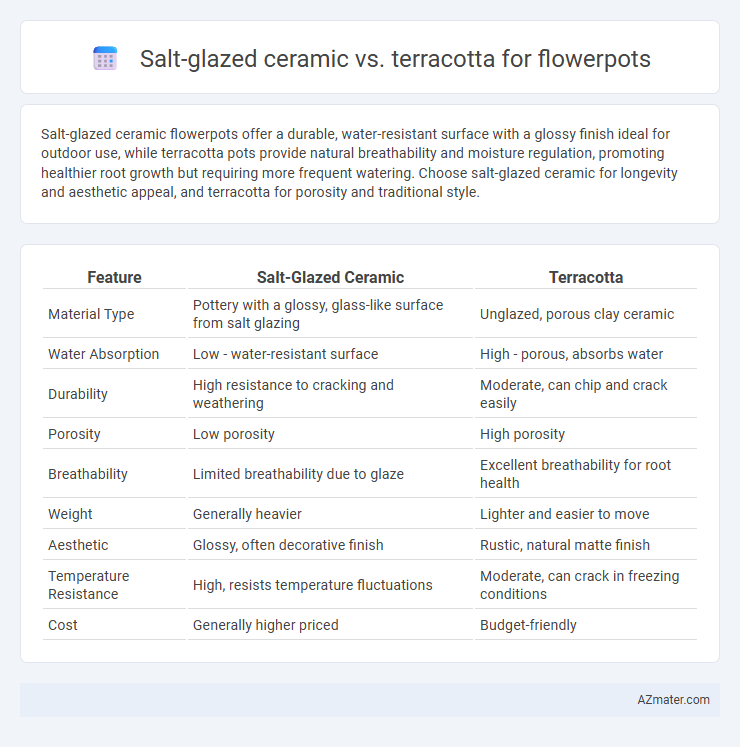Salt-glazed ceramic flowerpots offer a durable, water-resistant surface with a glossy finish ideal for outdoor use, while terracotta pots provide natural breathability and moisture regulation, promoting healthier root growth but requiring more frequent watering. Choose salt-glazed ceramic for longevity and aesthetic appeal, and terracotta for porosity and traditional style.
Table of Comparison
| Feature | Salt-Glazed Ceramic | Terracotta |
|---|---|---|
| Material Type | Pottery with a glossy, glass-like surface from salt glazing | Unglazed, porous clay ceramic |
| Water Absorption | Low - water-resistant surface | High - porous, absorbs water |
| Durability | High resistance to cracking and weathering | Moderate, can chip and crack easily |
| Porosity | Low porosity | High porosity |
| Breathability | Limited breathability due to glaze | Excellent breathability for root health |
| Weight | Generally heavier | Lighter and easier to move |
| Aesthetic | Glossy, often decorative finish | Rustic, natural matte finish |
| Temperature Resistance | High, resists temperature fluctuations | Moderate, can crack in freezing conditions |
| Cost | Generally higher priced | Budget-friendly |
Introduction to Salt-Glazed and Terracotta Flowerpots
Salt-glazed ceramic flowerpots feature a distinctive glassy surface created by a high-temperature sodium vapor glaze, offering enhanced durability and resistance to water absorption. Terracotta flowerpots, crafted from natural clay, provide excellent breathability and a porous texture that promotes healthy root growth through improved air and moisture circulation. Both materials cater to different gardening needs, with salt-glazed ceramics excelling in aesthetic longevity and terracotta prized for its traditional, earthy appeal and natural insulation.
Material Composition: Salt-Glazed vs Terracotta
Salt-glazed ceramics feature a vitreous, glass-like surface created by exposing clay to salt vapors during firing, resulting in a durable and water-resistant finish ideal for flowerpots. Terracotta is composed primarily of porous, unglazed clay with high iron content, which allows for excellent breathability and moisture regulation but requires sealing for water resistance. The key material difference lies in salt-glazed ceramics' non-porous, harder surface versus terracotta's natural, porous structure that affects plant watering and durability.
Porosity and Breathability for Plant Health
Salt-glazed ceramic flowerpots have a dense, vitrified surface with low porosity, reducing water absorption and limiting airflow to the soil, which may cause root rot in moisture-sensitive plants. Terracotta pots feature high porosity, allowing excellent breathability and moisture evaporation, promoting healthy root oxygenation and preventing waterlogging. For plants requiring well-drained soil and air circulation, terracotta flowerpots enhance root health through superior porosity and breathability compared to salt-glazed ceramics.
Durability and Longevity in Outdoor Conditions
Salt-glazed ceramic flowerpots offer superior durability and resistance to weathering compared to terracotta, making them ideal for prolonged outdoor use. The salt glazing process creates a vitrified surface that resists moisture absorption, reducing the risk of cracking during freeze-thaw cycles common in outdoor environments. Terracotta pots, while breathable and attractive, are more porous and prone to chipping or degradation when exposed to harsh weather over time.
Aesthetic Appeal and Color Variations
Salt-glazed ceramics offer a glossy, translucent finish with subtle variations in color due to the salt-firing process, creating a unique, often rustic aesthetic ideal for decorative flowerpots. Terracotta, characterized by its warm, earthy red or orange hues, provides a natural matte texture that ages gracefully, enhancing traditional garden or indoor plant settings. The choice between salt-glazed and terracotta flowerpots largely depends on desired color vibrancy and finish, with salt glazing providing more diverse color options and visual depth.
Weight and Handling Differences
Salt-glazed ceramic flowerpots are denser and heavier than terracotta, offering greater durability but making them less convenient to move. Terracotta pots are lighter and easier to handle, ideal for gardeners who frequently rearrange plants or need portable containers. The porous nature of terracotta also contributes to its lighter weight compared to the non-porous, thick salt-glazed ceramic surfaces.
Water Retention and Drainage Efficiency
Salt-glazed ceramic flowerpots feature a glassy surface that reduces water absorption, resulting in lower water retention but improved durability and drainage efficiency compared to terracotta. Terracotta pots, being porous, allow for better breathability and moderate water retention, which helps prevent overwatering but may require more frequent irrigation. The choice between the two depends on the plant's moisture needs, with salt-glazed ceramics favoring plants that require well-drained soil and terracotta suited for those needing consistent moisture.
Maintenance and Cleaning Requirements
Salt-glazed ceramic flowerpots feature a durable, non-porous surface that resists dirt and moisture, making them easier to clean with just a simple wipe or rinse. Terracotta flowerpots are porous, absorbing water and soil residue, which can lead to mineral buildup and staining, necessitating more frequent scrubbing and occasional soaking to maintain cleanliness. Regular maintenance of terracotta pots includes sealing treatments to reduce porosity, while salt-glazed ceramics require less upkeep due to their naturally smooth and sealed finish.
Cost Comparison: Salt-Glazed vs Terracotta
Salt-glazed ceramic flowerpots typically cost more due to their labor-intensive glazing process and higher firing temperatures, which enhance durability and aesthetic appeal. Terracotta pots, made from natural clay and fired at lower temperatures, are generally more affordable but less resistant to weathering and chipping. Choosing between the two depends on budget constraints and desired longevity, as salt-glazed ceramics offer a longer-lasting investment despite a higher upfront cost.
Best Uses: Matching Flowerpot to Plant Type
Salt-glazed ceramic flowerpots are ideal for moisture-loving plants such as ferns and orchids due to their waterproof, non-porous surface that retains humidity. Terracotta pots, made from porous clay, are best suited for drought-tolerant plants like succulents and cacti, as they allow for excellent air circulation and soil drainage. Choosing between salt-glazed and terracotta pots ensures optimal soil moisture levels tailored to the specific needs of each plant type.

Infographic: Salt-glazed ceramic vs Terracotta for Flowerpot
 azmater.com
azmater.com